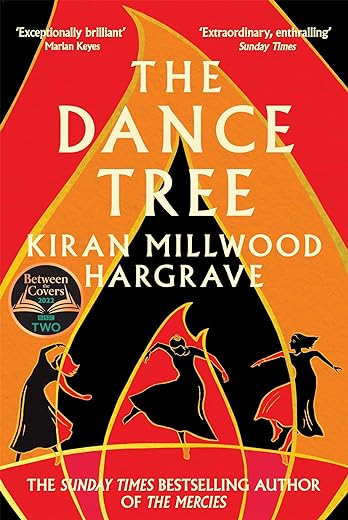The Dance Tree: The BBC Between the Covers Book Club Pick
£5.30£9.50 (-44%)
Set in an era of superstition and hysteria, and inspired by the true events of a doomed summer, The Dance Tree is a story of family secrets, forbidden love, and women pushed to the edge. The gripping, historical novel from Kiran Millwood Hargrave, as seen on BBC Two’s Between the Covers.
‘Brilliant’ – Marian Keyes
‘I absolutely loved this book’ – Elodie Harper, author of The Wolf Den
Strasbourg, 1518. In the midst of a blisteringly hot summer, a lone woman begins to dance in the city square. She dances for days without pause, and as she is joined by hundreds of others, the authorities declare an emergency: musicians will be brought in to play the Devil out of these women.
Beyond the city, pregnant Lisbet tends the bees that are her livelihood. And then, as the dancing plague gathers momentum, Lisbet’s sister-in-law Nethe returns from seven years’ penance in the mountains for a crime no one will name.
As the city buckles under the beat of a thousand feet, Lisbet finds herself thrust into a dangerous web of deceit and clandestine passion, but she is dancing to a dangerous tune . . .
Shortlisted for the HWA Gold Crown
‘Intriguing, haunting, beautiful’ – Jennifer Saint, author of Ariadne
‘Extraordinary, enthralling’ – Sunday Times
Read more










by nigel daniel
Not my usual reading material. Saw it reviewed on a tv show. Ordered it and loved it
by Melanie C
I loved this book from the first page. A compelling story of secrets, loves and mysteries set against a historical background of extreme religious fanatacism. It is beautifully written and you become totally involved in the characters and events. It made me smile and it made me cry. Have not read anything quite so moving.
by Jenny Shackley
took a little to get into, but then very readable. Enjoyed.
by Peter
Lots of it was really good, really good, the end just left me a little cold, as though it had not been finished or the author had simply had enough. Not sure if that’s the way it was meant to make me feel, thinking about it now perhaps that’s exactly what the author meant to do, but it just felt anticlimactic.
by Kizzia Mildmay
This book unsettled me from the first page and left me with a sense that part of my soul had been flayed raw. It is incredibly well written, the sense of time and place is impeccable, and it took me less than a week to finish it because I needed to find out what was going to happen. I found all the characters compelling, felt Ida’s journey to understand herself and what she was capable of completely believable, and I adored the way it revolved around the bee hives. It is without doubt a very good book and you can feel that Kiran poured a lot of herself into it (which is confirmed by the author’s note).
Yet I cannot say that I loved it unreservedly and I would not blithely recommend it to anyone and everyone. This story features abuse (domestic and perpetrated by religion), homophobia, and miscariage/child death so if you don’t feel able to deal with any of those at this moment in time, you are best to leave it for when you feel stronger. If you do feel that you can manage it, however, I would definitely recommend that you try.
by MumOfChops
I had high hopes for this book.
But at time I found myself skimming it as I had paid for it and felt I ought to see it out.
I love history books and I thought I would be fascinated. But it was more about the characters of the farm of bees than the dance plague itself – the dancing plague playing second backdrop to the central story.
I felt the plot was obvious – and whilst I love a good feminine lit text that sheds light on the inequality of women I just didn’t feel anything for any of the characters. Except maybe Sophey (randomly) and Eren (to my mind the best character in the book)
I sort of wish I’d given up on this one.
Maybe it wasn’t for me. I hope others enjoyed it more
by Craobh Rua
Kiran Millwood Hargrave was born in 1990, and is a graduate of both Cambridge and Oxford University. She was a published poet and playwright, before turning to children’s fiction – her work here has has won multiple awards. “The Dance Tree” is her second book for adults, and was first published in 2022.
“The Dance Tree” is set in 1518, and tells the story of Lisbet. She lives with her husband, Henne, and his mother, Sophey, on a farm just outside Strasbourg. Europe at this stage is suffering from a long drought, something that is widely viewed as judgement from God. What’s keeping the farm afloat is their colony of bees – and, since marrying into the family, Lisbet has become a talented beekeper. As the book opens, the family is preparing from the return of Nethe, Lisbet’s sister in law. Nethe has been away for seven years, serving a penance in the mountains – though what exactly Nethe had done is something of a mystery. As a result, Lisbeth and Nethe have never actually met – and Lisbeth is apprehensive about how Nethe will view her.
Lisbeth has had one constant friend since she joined the family – Ida Platter. Ida is married to the Twenty One’s chief henchman, and the couple seem to have nothing in common. (The Twenty One are essentially the arm by which Strasbourg’s cathedral governs the people). Ida is every bit as loving, generous and caring as her husband is mean and spiteful – but even she won’t tell her what Nethe is supposed to have done.
Nethe’s return coincides with an outbreak of dancing – and it’s more of a plague than a celebration. (This element of the story is based on true events). In July 1519, a woman called Frau Troffea began dancing on the streets of Strasbourg. She danced for days, unable to stop, and more and more peole joined her. Frau Troffea herself stopped dancing after being bathed at the nearby shrine to St Vitus, but the plague had taken many others. The Twenty One, the city’s council, are very disapproving : they view it as a judgement from God. (A great deal at the time seems to be viewed as a judgement from God : the dancing, the drought, a recent comet for example. Accordingly, the people of the city are treated vey harshly by the authorities).
Lisbeth is pregnant as the book opens, and is desperate to become a mother. (She is also afraid, having already been pregnant a dozen times, and miscarried each time). She, alone, has marked the deaths of her unborn children – each time, Henne and Sophey have harshly marked only her “failure”. Lisbeth has created a shrine for her lost children, at a dance tree in the woods near the farmhouse. The dance tree is “a thick trunked linden with a stage built into its branches.” However, she does keep it secret – as it’s a “relic of the pagans who had their churches open under God.” In times like this, such a thing would cause her great trouble.
I’ve visited Strasbourg several times over this last ten years or so – it’s a beautiful city, and I’ve become quite familiar with the old part of town. It was the book’s location that initially attracted my attention, as I’ve found it tricky to find books set there. I was a little disappointed, though – a few places (especially the cathedral) were mentioned by name, but I got no real sense of the city from the book. I couldn’t sha ke the feeling the book was a little formulaic. Much of the book saw Lisbeth running in a loop – from the farm, to the city to watch the dancers, and then to the Dance Tree before returning home. (I wasn’t entirely convinced by the book’s ending either). Nevertheless, a good book overall – although, for me, it didn’t quite live up to its billing.
by Liz
The print was very tiny and the paper quality poor therefore I couldn’t give this a higher feedback as waiting for the kindle price to lower.